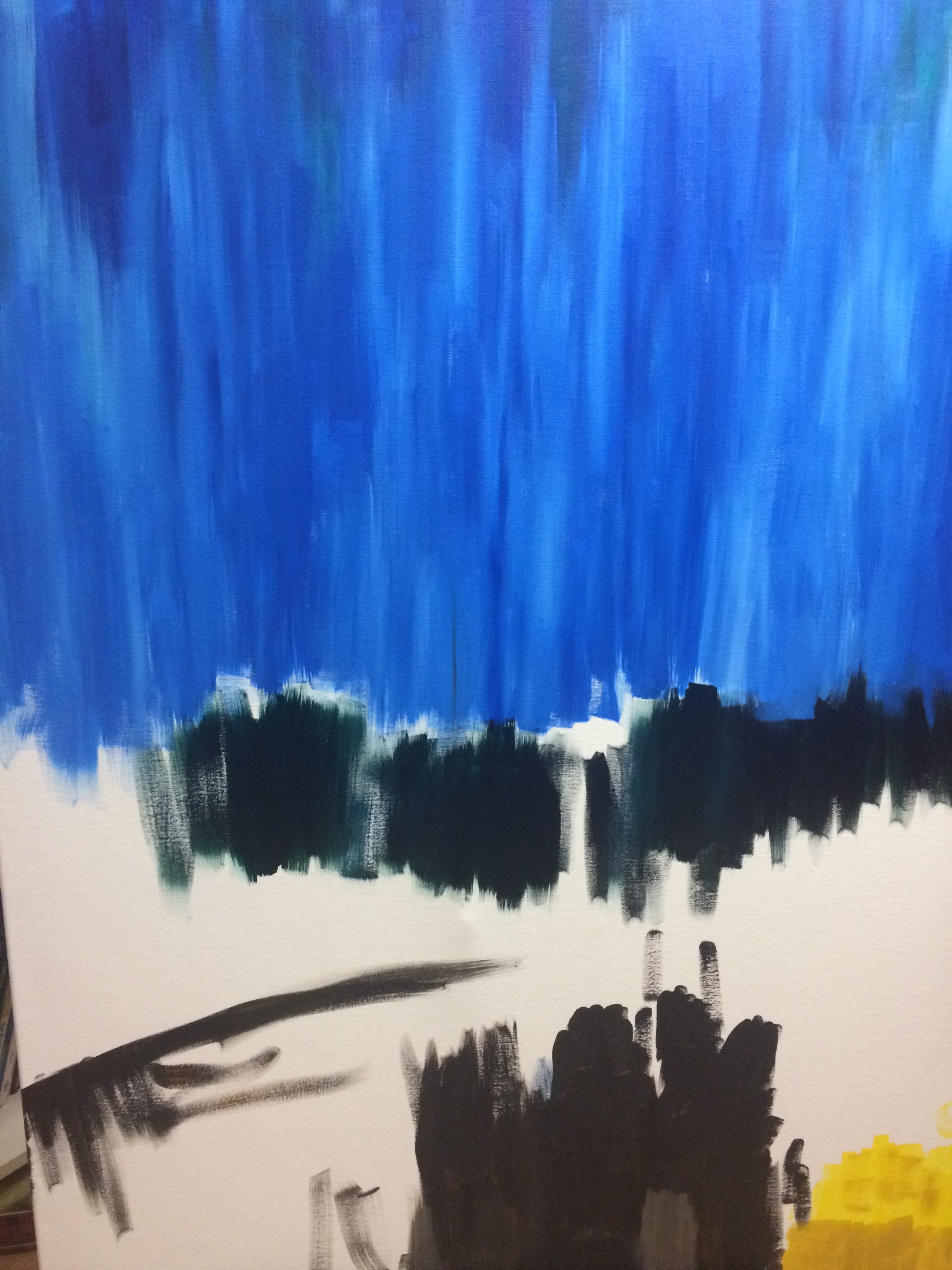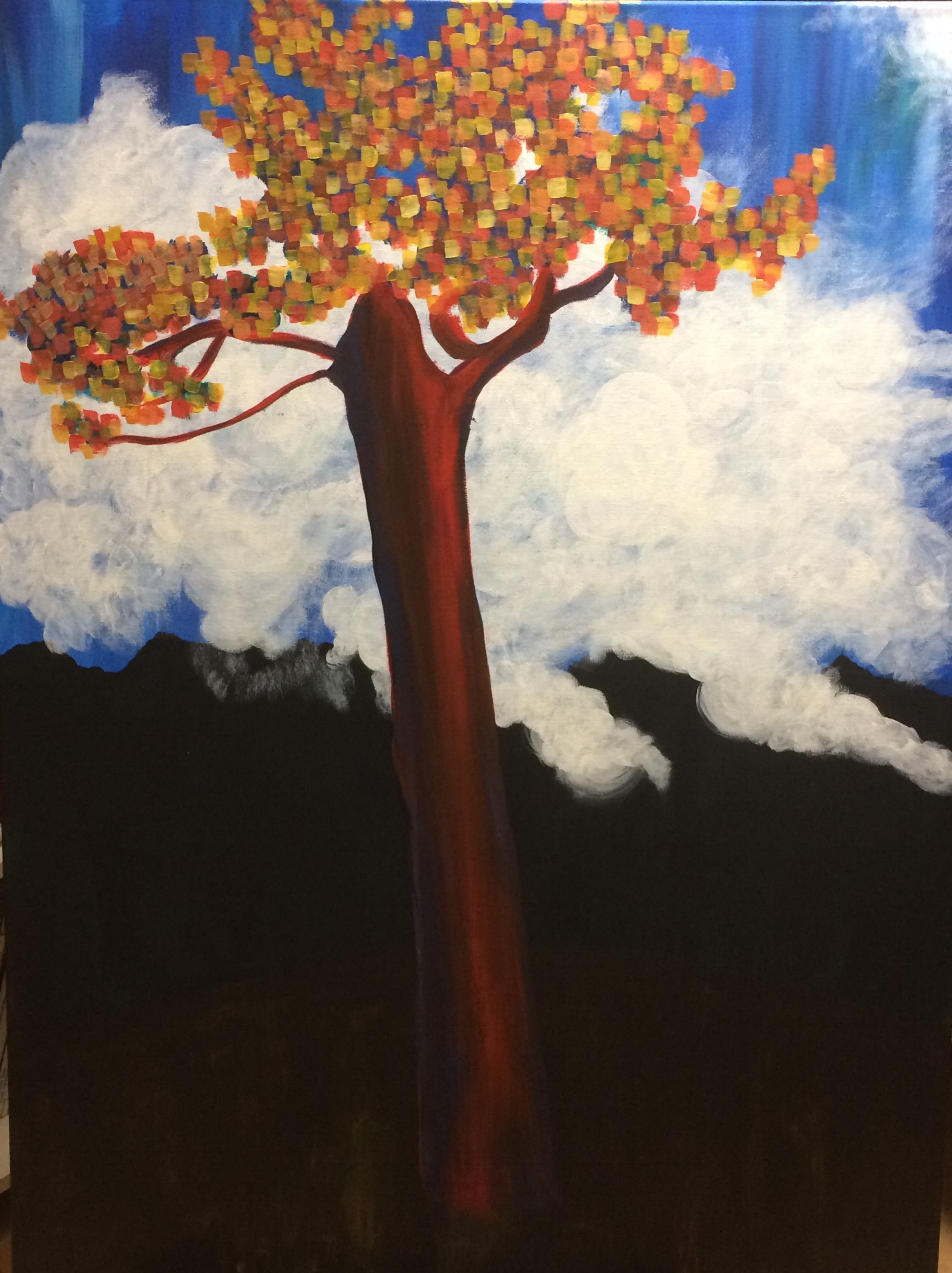How Squareism Came to Be
I’m not 100% classically trained. I’ve had many good art instructors who have taught me how to create shadows, make shapes with color, and balance negative and positive space. However, once I left their instruction I had to experiment a lot with my technique.
…
I’m not 100% classically trained. I’ve had many good art instructors who have taught me how to create shadows, make shapes with color, and balance negative and positive space. However, once I left their instruction I had to experiment a lot with my technique.
How I started Tree and Mountains ©Francesca Bandino
Through this experimentation I developed a style I like to call Squareism. It all started with my painting, Tree and Mountains. The picture was dark and the details weren’t clear. I started as usual with long visible brushstrokes for the background. Then I added the mountains and the clouds. I knew I didn’t want my tree to be black or grey, so I stepped back and studied my painting for quite a while. That day I decided to work on something else. I needed more time and I couldn’t solve my problems with that painting in that moment.
I thought about it and journaled about it at night. In my mind I saw a red tree. It was whimsical and would look bright against the background. You see, I don’t always like to paint what’s in front of me. I want to make my world more colorful.
This image shows how I started the red tree ©Francesca Bandino
The next day I went back to work and added layers of reds and blue. I had created the tree I saw in my mind, but I still needed leaves. What did these leaves look like? I couldn’t tell. The image was just too dark.
What I created was a cloud of purple and blue – not exactly what I was going for. Ok, what would look good with this tree? I decided on yellow and red leaves, like the ones that indicate that autumn has arrived. I had beautiful new brushes, but they weren’t quite right for the kind of leaves I was trying to make.
I dipped my flat brush into my yellow paint and made a short brush stroke, then another. Then I dipped it into the red paint and made some more. I stepped back and looked at what I had created. I liked it! It gave a certain amount of depth to the foliage that changed as I moved around my studio. Still, something was off-balance, so I added some squares around the tree where the soil would be. I made green and brown squares, but not too many.
Almost done...just about to add the soil. ©Francesca Bandino
At each one of my shows, those who see my work are surprised by my Squareism paintings. They resemble some post-impressionistic styles like pointillism, but they aren’t quite the same. I don’t get the same reaction from people who see this style in pictures because it doesn’t have the same effect. The cool thing about my Squareism technique is that your distance or angle from the painting can change the way the colors blend.
I knew I was onto something with this style and the fact that I had started it on a 40x30 inch canvas was liberating. I went to work finding pictures I had taken on my travels of interesting trees so I could incorporate them into my collection. I don’t always use Squareism in my paintings because it won’t always help me accomplish what I envision. Instead it’s more like a tool that I get to keep in my back pocket for another day.
Painting Outdoors
In art we often talk about inspiration. Going out, seeing different sights and experiencing new things can contribute to our inspiration because they open our mind to other possibilities. In July 2017 I started painting in my garden, and I discovered that it drives me to paint endlessly.
In art we often talk about inspiration. Going out, seeing different sights and experiencing new things can contribute to our inspiration because they open our mind to other possibilities. In July 2017 I started painting in my garden, and I discovered that it drives me to paint endlessly.
I’ve heard that if you really want to paint then you’ll paint anywhere. Though this is mostly true, I don’t believe that I paint at my best from anywhere. In my previous life, I wasn’t happy being stuck indoors and depriving myself of sunlight. So why was I staying indoors now that I had the power to choose if to go outside to work?
Maybe it was habit or maybe it was the fact that I didn’t want to move all of my materials outside. Regardless, I stayed in my basement studio for a good portion of the summer. In fact, I had attempted to paint outside once before, but I did it all wrong. I was painting from a picture under the 2:30 pm sun. The light was reflecting off my painting while the colors on my palette dried too quickly for me to use them. Painting like this was not enjoyable.
So the second time I attempted to paint outside, I made sure to paint in the shade and while it was still cool out. Painting became my morning priority. Suddenly nothing could pull me away from my canvas – except maybe lunch.
Outside, everything around me is inspiration and I’m able to use shade to my benefit. When the sunlight moves directly into my eyes or onto my painting, I simply pause that painting and move to a new spot to work on a different painting. The interruption allows me to decide what looks best on my canvas, using the plant or flower only as inspiration for what I create.
Pictures don’t always show all the details I want to see. So when I’m painting from one of my photographs, I have to fill in the blanks with my imagination. While painting from a picture forces me to invent, when I’m painting outside I’m only responsible for creating. I don’t think that one approach is better than the other, they’re simply different. When I paint inside, I study my canvas. I study the colors and shapes and how they interact. I dream of those paintings and journal about them. I create a more colorful and bright world to compensate for what I don’t have indoors in the winter months.
When I paint outside I don’t go through the same process. I merely paint what I find interesting. I sit on the grass or in a chair, lay some colors that I see onto my palette, and then I paint what I want to focus on. My colors aren’t mixed to be realistic and match what’s in front of me. They’re mixed in a way that expresses what I feel when I look at that plant or flower in that moment. There’s very little afterthought. I journal about what I’ve painted and move on to the next painting. It’s simple.
THE STORY OF “BEET SALAD”
Beet Salad changed the way I create and here's how.
Disclaimer: This is not a story about beets.
I’m sometimes asked how I learned to make my backgrounds the way I do. That story is also the story behind my painting called “Beet Salad.” (Ok, maybe there are some beets involved, but moving on…) A few very important things happened when I created this painting.
First, I had better materials
When I quit my first “real” job and went to Italy, I bought new painting supplies from the local art supplies store. When I came back to the U.S. and travelled to Italy on vacation, I was able to use the supplies I had left there.
©April 2014, Francesca Bandino, Beet Salad. Acrylic on Canvas, 16.1x13 inches
I really only had two brushes – no more, no less – but they were two excellent brushes. In addition, I was using professional-grade paints and the difference from student-grade was significant. The colors became bolder and more vibrant. The paints didn’t feel watery under my brush. They were full-bodied and I could actually feel what I was creating.
I had laid my canvas paper on the floor; I didn’t have an easel. I painted on the floor with my whole body, not just my hand. Every brushstroke was intentional even though I hadn’t put much thought into a single one of them.
No more paint was wasted
I had created streaks with paint left over from another painting. They had been created the year prior and then the unfinished canvas was left there when I moved my life back to the U.S, but they were just random green and gold streaks. I decided to add more green to those until my canvas was filled with color. I couldn’t remember the last time I had filled a whole canvas. My flat brush moved from the top of the canvas to the bottom and then back up again. I was careful not to ruin my precious brushes.
The background was vibrant. It could have stood alone because the movement of the lines was enough stimulation for my eyes, but I knew I wasn’t finished yet.
No more sketches
While I was on vacation, I wanted to paint and I didn’t have any sketches that motivated me to create. Not working from a sketch allowed me to paint more freely. As some art instructors of mine have said, painting is not drawing with paint. Therefore, it is creating something with colors rather than lines.
At this point in time we were still in the early stages of smartphones, so I had a bunch of useless pictures of things I had found interesting or weird at any given moment. After I had completed the background, I looked through my pictures to find something that would pique my interest. I found it – a picture of a beet salad I had gotten at a fancy restaurant! I knew that the orange and pink would stand out on the green canvas.
Colors became my priority
I painted colors that would look good together rather than a subject that would be interesting. How many people think cut-up beets are interesting? Not too many, I would assume. The colors led me to another path – nothing was what it seemed. Those dots you see, they were originally crumbs on my plate. I know, you thought they were sea bubbles, but they’re not. I used the other end of my paint brush to create them, not the end with the bristles. The beets, well, if I hadn’t told you that they were beets, would you have known? Mostly I’ve been asked if they are some sort of shell fish they can’t identify. What about those curly wisps? They’re just some food decoration, nothing exotic.
This painting marked a turning point for me, and I moved from being a realistic painter to being an expressionistic painter. It’s not about what you see in my paintings but how they make you feel when you look at them. What do you feel when you look at this painting?


















